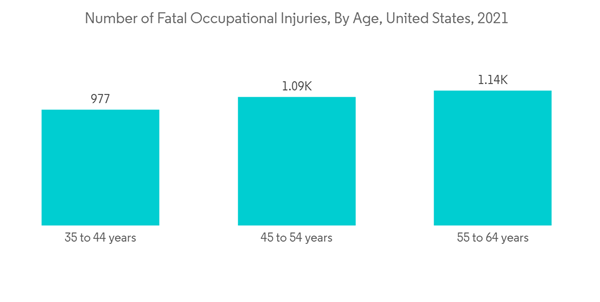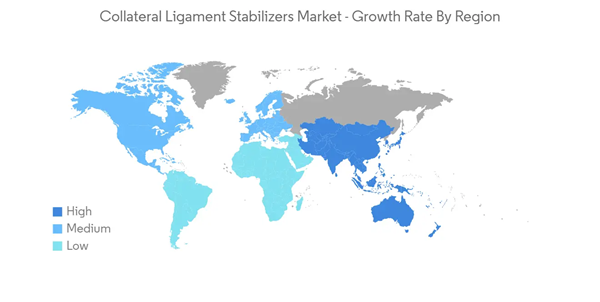At the beginning of the COVID-19 pandemic, the studied market was hampered, followed by the cancellation of medical visits and disease diagnoses. This resulted in delays in orthopedic procedures during the initial phases of the pandemic. In addition, there was a decrease in sports activities due to the closure of sporting grounds and fitness centers, owing to the widespread advice to avoid human interaction to reduce the spread of coronavirus. Thus, sports participation decreased during the pandemic. For instance, according to an article published in the BMJ Open Sport and Exercise Medicine Journal in March 2022, a dramatic decrease in sports participation was seen during the pandemic phase, and sports participation decreased by up to 15% per month in the total population aged 5 to 80 years of age. As collateral ligament injury is a common injury among athletes, the decrease in sports activities disrupted the demand and supply of collateral ligament stabilizers during the pandemic phase. However, as the situation worldwide has normalized and all the sports activities have been operating at a normal pace, the market has reached its pre-pandemic level growth and is expected to continue the trend over the forecast period.
Factors such as the increasing number of joint disorders, increasing road accidents and sports-related injuries, and a rise in the geriatric population are expected to fuel the market growth over the forecast period.
Physicians often suggest using collateral ligament stabilizer (CLS) systems, such as specific braces, to treat muscular or joint diseases that cause pain. Individual differences in pain include intense pain, shocking pain, and pain that worsens with movement. Hence, the use of CLS provides relief to patients with orthopedic conditions, especially patients recovering from injury-related surgeries. In addition, ligament injuries are more common in people engaged in sports activities. As per the data updated by the American Academy of Orthopaedic Surgeons (AAOS) in January 2021, collateral ligament damage is common damage among the sports group, and knee bracing stabilizer systems are more commonly prescribed to athletes for treatment. Thus, the burden of collateral ligament injuries among sports persons is anticipated to increase injury-related surgeries and treatments, further creating new opportunities for collateral ligament stabilizers. This is expected to contribute to the overall market growth.
Furthermore, the increase in the geriatric population is expected to be a major contributor to the studied market. According to World Health Organization (WHO) data published in October 2021, between 2015 and 2050, the proportion of the world's population over 60 years is predicted to nearly double from 12% to 22%. By 2050, 80% of older people will live in low- and middle-income countries. This target population is more prone to getting age-related joint disorders and fractures due to falls requiring surgeries for treatment. Thus, it is expected to generate demand for CLS systems such as braces for pain relief. Hence, it is expected to drive market growth over the forecast period.
However, the lack of awareness regarding collateral ligament stabilizers and the high cost of knee replacement and knee surgeries is predicted to hinder the market's growth.
Collateral Ligament Stabilizers Market Trends
Medial Collateral Ligament Stabilizers are Expected to Have Significant Growth Rate over the Forecast period
Collateral ligament injuries are more common in athletes playing football or soccer. Thus, with the increasing sports activities, medial collateral ligament (MCL) injuries are increasing, which is fueling the segment's growth.The increasing sports activities are contributing to the market growth. For instance, as per the John Hopkins University data updated in January 2023, while nearly 30 million children and teens age population participate in at least one form of organized sports, the number of injuries is approximately 3.5 million or more every year. Also, more than one-third of all injuries are sports-related injuries among the target population. These sports injuries are expected to create the burden of MCL injury, further fueling the demand for MCL stabilizers. Hence, accelerating the segment growth over the forecast period.
In addition, knee swelling, locking or catching of the knee while moving, pain, and tenderness along the inside of the joint are the symptoms of MCL injury. This is further anticipated to create demand for collateral ligament stabilizers for MCL injury treatment. This is anticipated to fuel the segment growth over the forecast period.
North America is Expected to Hold Major Market Share Over the Forecast Period
North America is one of the major contributors to the studied market, owing to increasing injuries and growing geriatric populations prone to age-related collateral ligament injuries.The United States holds the largest share among the other countries in the region. Factors such as the high incidence rate of ligament injuries owing to increasing sports activities are major contributors to the studied market growth in the country. Basketball, football, soccer, and skiing are common sports linked to collateral ligament injury. As per the data updated by the National Safety Council (NSC) in January 2022, nearly 3.2 million people were treated in emergency departments for injuries involving sports and recreational equipment, and most of the activities were frequently associated with exercise, cycling, and basketball. Thus, such a high number of people suffering from sports-related injuries is anticipated to create opportunities for collateral ligament stabilizers and accelerate the market's growth over the forecast period.
Besides, the occurrence of ligament injury among the elderly population is one of the major factors that is creating demand for various types of ligament stabilizers in the market. As per a research study published in Sports Health Journal in June 2021, the number of collateral ACL reconstructions in older patients is rising, and more than 120,000 ACL reconstructions are performed in the United States annually. Thus, collateral ligament stabilizers are used and prescribed to patients to correct and restore anatomic length, rotation, and angulation of a patient-specific injury. This is further expected to contribute to the market growth in the region.
Therefore, owing to the aforesaid factors, North America is expected to hold a prominent share of the market studied over the forecast period.
Collateral Ligament Stabilizers Industry Overview
The collateral ligament stabilizers market is moderately competitive. In terms of market share, local and global players compete to gain a competitive advantage. The market players are engaged in expanding their product portfolio and maintaining their presence in the worldwide market. Some market players operating in the collateral ligament stabilizers market include Bauerfeind, DJO GLOBAL, INC., DeRoyal Industries, Inc., Össur, and Orthofix US LLC (Breg, Inc.), among others.Additional Benefits:
- The market estimate (ME) sheet in Excel format
- 3 months of analyst support
This product will be delivered within 2 business days.
Table of Contents
Companies Mentioned (Partial List)
A selection of companies mentioned in this report includes, but is not limited to:
- Bauerfeind
- Enovis (DJO Global, Inc.)
- DeRoyal Industries, Inc.
- Ossur
- DARCO International, Inc.
- Orthofix US LLC (Breg, Inc.)
- Thuasne USA
- Bio Dynamic Technologies
- BSN Medical










